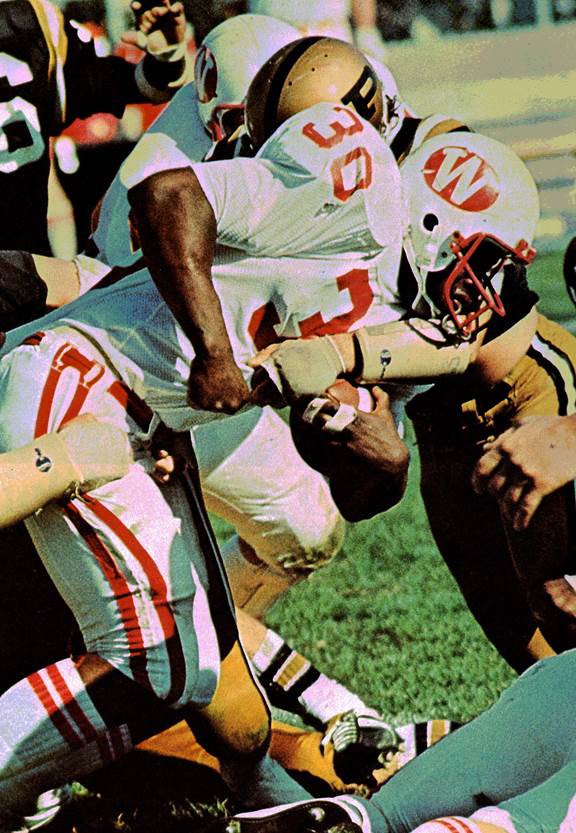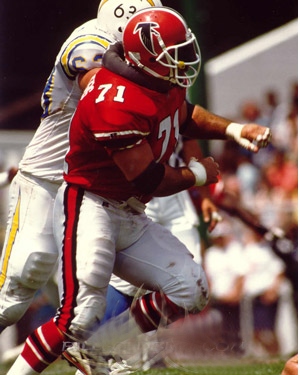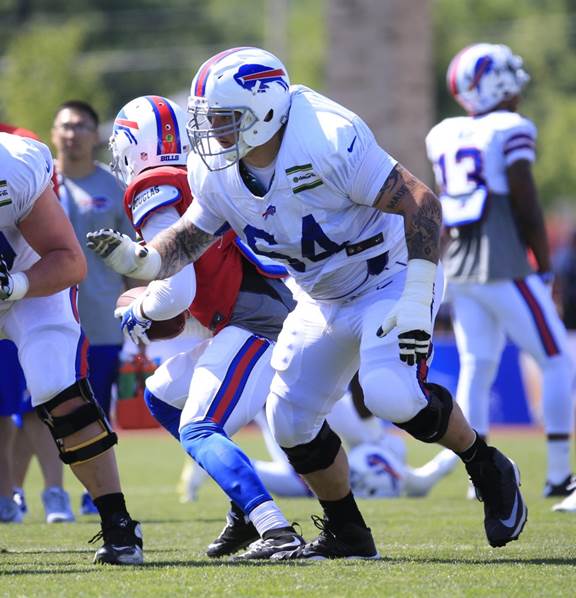

THEY USED TO CALL IT FOOTBALL, PART TWO
HELMET HUT NEWS/REFLECTIONS October 2015:
THEY USED TO CALL IT FOOTBALL, PART TWO
The September 2015 HELMET NEWS/REFLECTIONS column included the following:
By Dr. Ken
“Allow me to interject that the
author and the entire staff of
HELMET HUT
agrees that the physical safety
and well-being of every player
is, and must be the foremost
consideration in presenting
every aspect of the game. That
however, puts the following
question squarely in the
forefront of what must be
addressed regarding both the way
in which the game is played
relative to the ‘old days,’ and
what is best regarding player
safety: ‘Is the new game of
football the way it is played
and practiced more conducive to
long term injury and the
production of potential brain
damage compared to the way it
used to be?’”
 |
Wisconsin’s Larry Canada faced a lot of weekly tackling in practice in 1975. Facing off full speed versus Purdue was just “business as usual,” unlike today’s game of football with its limited game preparation contact
The number of debilitating
brain related, catastrophic
cervical spine, and head
injuries suffered by the
previous two generations of
football players is the
constant reminder that the
health of players at all
levels must remain the
priority of the game.
However, like other areas of
our culture that have been
altered through the past
three decades, have we
created a situation that now
produces an increased number
of injuries? As a former
player who competed with
extremely limited ability
and football talent relative
to my peers, I was exactly
the type of player most
prone to injury. Those with
a great deal of football
and/or athletic talent can
perform at their best and
usually still perform well
when they are below their
best. If injured, they know
they can “sit” and take some
time to either heal or
return to feeling their best
before resuming their
on-field practice and game
responsibilities. Players
like me did not have that
luxury. Fanatically lifting
weights from the age of
twelve when few athletes
lifted weights and most
coaches discouraged the
activity, and pushing my
muscular weight-to-height
ratio to its absolute limit
was a necessity. I did not
view this as unusual, being
part of a group of lifting,
running, and fitness
devotees who were well aware
that we needed to do
whatever was possible to
make up for a lack of
athletic ability. If
injured, we would not leave
the field, we would not
allow any indication of
injury, and we would most
often not seek the advice or
treatment of any team
related personnel. For me,
this became a habit that was
more or less encoded in
junior high school. It was
not borne of toughness but
rather, fear and insecurity,
having a certainty that once
taken off of the field I
would never be allowed to
return. Those players that
fully understood their
limitations and were willing
to put up with a degree of
bodily damage were most
prone to eventual long term
dysfunction.
 |
 |
Concussion and broken bones that involved “minor” body parts like the fingers, hands, and forearms could be ignored and disguised. Being unconscious for a minute or two was still considered “a ding,” perhaps a “major ding” but no more than a brief interruption to an immediate return to the field during practice or games. Obviously, this holds the potential for serious and unrelenting health related problems later in life. It is certainly positive that steps have been taken to improve the equipment as well as practice and play procedures in an attempt to prevent recent players from suffering similar damage. That said it is also true that to play football safely and effectively, one must attain a certain minimal level of fitness, specific conditioning, strength, and resiliency before they begin the year’s participation. Despite the complaints of many old timers that “the game just isn’t the same,” the author and staff of HELMET HUT are in agreement that any rules changes that better serve to protect the head and neck are positive. The change in tackling procedures that were mandated in 1976 after a series of lawsuits against helmet manufacturers [see HELMET NEWS/REFLECTIONS February –December 2004] were proven to reduce the number of head and cervical spine injuries suffered on the field.
However, this leads to the question we have proffered for this month, and one that the inordinate number of National Football League pre-season injuries shines a light on: has the intent to protect the players by limiting mandatory team related drills, strength training sessions, and contact in practice now led to a proliferation of injuries due to a lack of appropriate physiological preparation? To my knowledge, no legitimate studies have been done to determine if for example, the number of injuries significant enough to miss regular season games suffered from the beginning of camp through the first two games of the season, are now more or less than those suffered within the same time and game frame of ten or fifteen years ago? Are the collective bargaining agreement and other medically related mandates passed down as “normal operating procedure” preventing or causing injury to NFL players? “No one tackles any more” is a common complaint and observation of fans, scouts, and coaches at all levels. In truth, pro coaches in private discussions have observed this for a number of years. It is agreed that there just isn’t enough allowed time given to general contact drills and specific tackling drills to expect players to tackle effectively or consistently well. Observation of any pro training camp would shock the typical fan once they noted the very obvious lack of contact of any type!
I believe it is “common knowledge” that the quarterbacks entering the NFL in the past few seasons are not prepared to play the professional game. Certainly media reports that a specific quarterback “has never taken a snap under center” and that some “haven’t even huddled since high school” are now old news. Pro coaches understand that coming from systems that are far different than what is represented by the professional game make even the most talented collegiate quarterback a “project.” Not understood by the general football public is that even the best offensive linemen, including All Americans, do not know how to block by NFL standards. It might be obvious to state, “His team throws the ball seventy times a game” or “They don’t run enough for him to run block well, he doesn’t have the experience”, but in truth, many if not most offensive linemen in college cannot pass block either. Skeptics will huff and puff and note that on its face, this seems like a ludicrous statement but collegiate linemen, as a general statement, know how to screen opponents or get their body in the way of an onrushing defender, but less frequently, year by year in the game that is played now, understand how to truly pass block. Their relative lack of consistent contact in practice periods also limits their application of proper on-field techniques. Thus, while we accept that a quarterback who has been in a spread system throughout high school and college may take years of re-training, so do offensive linemen. The equivalent of teaching new techniques to counter defensive players with great athletic ability also means that these individuals are not physically prepared to play at the highest level. This too contributes to the inordinately high rate of injury.
 |
Buffalo Bills Guard Richie Incognito came out of Nebraska with run blocking skills and remains one of the best maulers in the NFL, with a full understanding of run game blocking
Limited exposure to necessary professional positional techniques, a shortage of mandatory strength and conditioning sessions, an absence of individual or team contact opportunities prior to the actual game experience, and the heretical statement that many professional level players are “just not that good” relative to the much more limited numbers that had job opportunities when there were fewer teams and smaller rosters have all made for an increasingly dangerous game. Are there viable solutions?
More Next Month